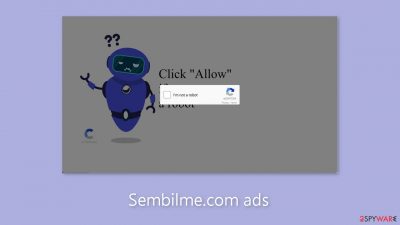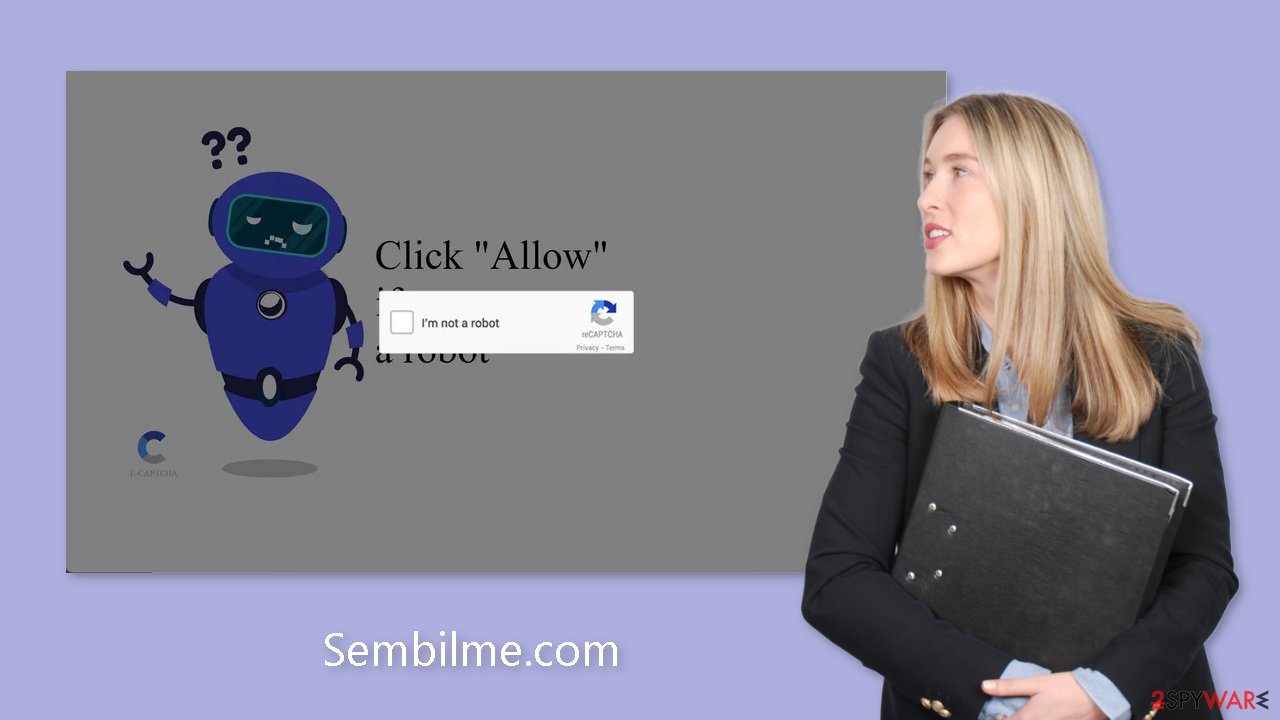Sembilme.com ads (spam) - Free Guide
Sembilme.com ads Removal Guide
What is Sembilme.com ads?
Sembilme.com can cause annoying pop-up spam if users click “Allow”

Sembilme.com is a deceptive website that uses tricks to persuade people into subscribing to push notifications. The layout of the website resembles a captcha verification process and prompts users to click the “Allow” button to confirm their human identity. However, users are unaware that granting permission allows the website to bombard them with intrusive pop-up advertisements.
The constant stream of these ads becomes an annoyance, appearing even when the browser is closed. Because the website's creators make money from pay-per-click advertising, they show little concern for user privacy or security. Crooks may use rogue advertising networks[1] to display ads that lead to malicious websites.
As a result, users may be redirected to pages that attempt to trick them into disclosing personal information, downloading potentially unwanted programs (PUPs),[2] or even downloading malware. These advertisements may promote bogus software deals, deceptive giveaways, fraudulent antivirus offers, and other deceptive content.
| NAME | Sembilme.com |
| TYPE | Push notification spam; adware |
| SYMPTOMS | Annoying pop-up ads start appearing in the corner of the screen, sometimes even when the browser is closed |
| DISTRIBUTION | Shady websites, deceptive ads, freeware bundling |
| DANGERS | Links embedded in the pop-ups may lead to dangerous pages where people can get tricked into providing their personal information or downloading PUPs and malware |
| ELIMINATION | Disable push notification via browser settings |
| FURTHER STEPS | Use a maintenance tool like FortectIntego to clear your browsers from cookies and cache |
Distribution methods
Such pages are rarely found in search results. They are usually found on unregulated and dubious websites. Illegal streaming platforms, for example, are notorious for hosting deceptive advertisements and covert redirects. These platforms may even display bogus “Download” and “Play” buttons that redirect to malicious websites.
It is critical that you only visit websites that you are familiar with and trust. Avoid clicking on random links and advertisements, even if they appear to promote legitimate products and services. It is best to go straight to the source because fraudsters can use well-known companies' branding and logos to make their advertisements appear legitimate.
Another possibility is that Sembilme.com appeared without user intervention. This occurrence could be the result of an adware[3] infection. Adware can cause a flood of commercial content, such as pop-ups, banners, and redirects. Individuals typically inadvertently infect their devices by installing software from freeware distribution platforms.

Disable the pop-ups
The first thing you should do is go to your browser settings and see if you can disable the push notifications from there:
Google Chrome (desktop):
- Open Google Chrome browser and go to Menu > Settings.
- Scroll down and click on Advanced.
- Locate Privacy and security section and pick Site Settings > Notifications.
![Stop notifications on Chrome PC 1 Stop notifications on Chrome PC 1]()
- Look at the Allow section and look for a suspicious URL.
- Click the three vertical dots next to it and pick Block. This should remove unwanted notifications from Google Chrome.
![Stop notifications on Chrome PC 2 Stop notifications on Chrome PC 2]()
Google Chrome (Android):
- Open Google Chrome and tap on Settings (three vertical dots).
- Select Notifications.
- Scroll down to the Sites section.
- Locate the unwanted URL and toggle the button to the left (Off setting).
![Stop notifications on Chrome Android Stop notifications on Chrome Android]()
Mozilla Firefox:
- Open Mozilla Firefox and go to Menu > Options.
- Click on Privacy & Security section.
- Under Permissions, you should be able to see Notifications. Click the Settings button next to it.
![Stop notifications on Mozilla Firefox 1 Stop notifications on Mozilla Firefox 1]()
- In the Settings – Notification Permissions window, click on the drop-down menu by the URL in question.
- Select Block and then click on Save Changes. This should remove unwanted notifications from Mozilla Firefox.
![Stop notifications on Mozilla Firefox 2 Stop notifications on Mozilla Firefox 2]()
Safari:
- Click on Safari > Preferences…
- Go to the Websites tab and, under General, select Notifications.
- Select the web address in question, click the drop-down menu and select Deny.
![Stop notifications on Safari Stop notifications on Safari]()
MS Edge:
- Open Microsoft Edge, and click the Settings and more button (three horizontal dots) at the top-right of the window.
- Select Settings and then go to Advanced.
- Under Website permissions, pick Manage permissions and select the URL in question.
![Stop notifications on Edge 1 Stop notifications on Edge 1]()
- Toggle the switch to the left to turn notifications off on Microsoft Edge.
MS Edge (Chromium):
- Open Microsoft Edge, and go to Settings.
- Select Site permissions.
- Go to Notifications on the right.
- Under Allow, you will find the unwanted entry.
- Click on More actions and select Block.
Protect your data while browsing
You may have noticed that almost every website you visit asks you to “Allow” cookies. These small data files can track information such as your IP address, geolocation, visited websites, clicked links, and online purchases. In general, this practice is not harmful because it helps websites personalize the user experience.
Nonetheless, malicious individuals can use this information to their advantage. Cookies can be sold to ad networks or other third-party companies. Cookies can be hijacked and exploited for nefarious purposes if the websites you visit lack robust security measures.
As a result, it is critical to clear your browser's cookies on a regular basis. Maintenance tools such as FortectIntego can be used to automate this task. These tools are capable of removing all cookies and cache, as well as repairing system damage such as errors and registry issues. This is especially useful after a virus infection, as it ensures a safer and more secure browsing experience.
Adware removal
Even after you disable notifications, adware may still be present in your system. Commercial content such as surveys, banners, pop-ups, and redirects may appear more frequently. To effectively address these symptoms, we strongly advise you to scan your machine with professional security tools such as SpyHunter 5Combo Cleaner or Malwarebytes.
These tools can detect suspicious processes on your computer and remove any associated files. Furthermore, they can issue warnings about potentially dangerous downloads, preventing future infections. While manual removal is an option, identifying potentially unwanted programs (PUPs) can be difficult because they frequently disguise themselves as seemingly useful tools that are commonly used, such as antivirus software, system optimizers, media players, and others.
Additionally, manual removal may inadvertently leave behind residual files and entries, leading to a resurgence of the infection. However, if you prefer to proceed with manual removal, you can follow the instructions provided below for both Windows and Mac systems:
Windows 10/8:
- Enter Control Panel into Windows search box and hit Enter or click on the search result.
- Under Programs, select Uninstall a program.
![Uninstall from Windows 1 Uninstall from Windows 1]()
- From the list, find the entry of the suspicious program.
- Right-click on the application and select Uninstall.
- If User Account Control shows up, click Yes.
- Wait till uninstallation process is complete and click OK.
![Uninstall from Windows 2 Uninstall from Windows 2]()
Windows 7/XP:
- Click on Windows Start > Control Panel located on the right pane (if you are Windows XP user, click on Add/Remove Programs).
- In Control Panel, select Programs > Uninstall a program.
![Uninstall from Windows 7/XP Uninstall from Windows 7/XP]()
- Pick the unwanted application by clicking on it once.
- At the top, click Uninstall/Change.
- In the confirmation prompt, pick Yes.
- Click OK once the removal process is finished.
Mac:
- From the menu bar, select Go > Applications.
- In the Applications folder, look for all related entries.
- Click on the app and drag it to Trash (or right-click and pick Move to Trash)
![Uninstall from Mac 1 Uninstall from Mac 1]()
To fully remove an unwanted app, you need to access Application Support, LaunchAgents, and LaunchDaemons folders and delete relevant files:
- Select Go > Go to Folder.
- Enter /Library/Application Support and click Go or press Enter.
- In the Application Support folder, look for any dubious entries and then delete them.
- Now enter /Library/LaunchAgents and /Library/LaunchDaemons folders the same way and terminate all the related .plist files.
![Uninstall from Mac 2 Uninstall from Mac 2]()
How to prevent from getting adware
Stream videos without limitations, no matter where you are
There are multiple parties that could find out almost anything about you by checking your online activity. While this is highly unlikely, advertisers and tech companies are constantly tracking you online. The first step to privacy should be a secure browser that focuses on tracker reduction to a minimum.
Even if you employ a secure browser, you will not be able to access websites that are restricted due to local government laws or other reasons. In other words, you may not be able to stream Disney+ or US-based Netflix in some countries. To bypass these restrictions, you can employ a powerful Private Internet Access VPN, which provides dedicated servers for torrenting and streaming, not slowing you down in the process.
Data backups are important – recover your lost files
Ransomware is one of the biggest threats to personal data. Once it is executed on a machine, it launches a sophisticated encryption algorithm that locks all your files, although it does not destroy them. The most common misconception is that anti-malware software can return files to their previous states. This is not true, however, and data remains locked after the malicious payload is deleted.
While regular data backups are the only secure method to recover your files after a ransomware attack, tools such as Data Recovery Pro can also be effective and restore at least some of your lost data.
- ^ Zeljka Zorz. How does a rogue ad network function?. Helpnetsecurity. IT Insights.
- ^ Wendy Zamora. What is a PUP? – How to avoid potentially unwanted programs. Malwarebytes. Security Tips and Tricks.
- ^ Adware. Webroot. Security for businesses.












